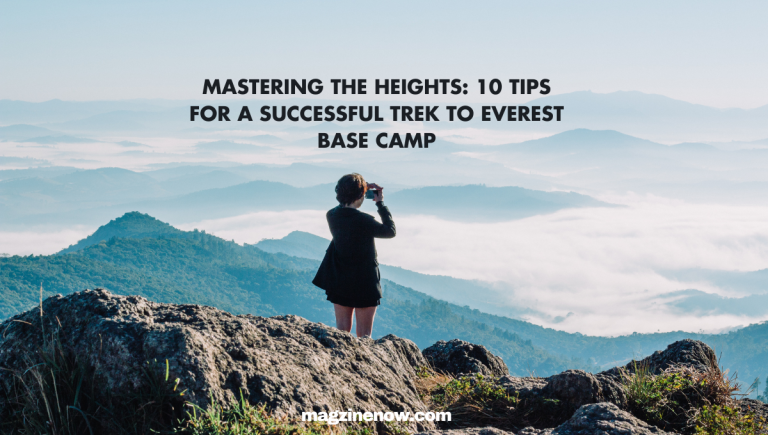Introduction:
EBC is the dream destination for many explorers and the people who love nature. The journey to EBC passes through the majestic beauty of the Himalayas. The scenic beauty along with exposure to numerous cultures is worth the hardship. This is not forgetting being able to conquer one of the globally famous walking destinations. however, one has many difficulties in hiking towards EBC, and it is important to consider the arrangements so that you enjoy the trip. The main purpose of this guideline is a detailed description of ten significant recommendations on how to best organize your trip to Everest Base Camp.
Physical Preparation:
Trekking to Everest Base Camp involves walking 3-5 hours per day in different terrain and elevations and thus requires a certain degree of physical fitness. Try to stick to a routine gym training program. It should comprise all types of physical activities such as cardio, weight training, and aerobics among others. Add some uphill and downhill walking as your practice because you have to cope with these during the entire trek. Strengthening your leg muscles, your core muscles, and your cardiovascular system will be extremely helpful.
Acclimatization Planning:
Adaptation is an essential part of walking at great heights. Good preparation should avoid altitude diseases which lead to acute mountain sickness (AMS). Your body needs time to get used to the gradually decreasing level of oxygen by gradually climbing up. Many trekking itineraries to the Everest base camp involve an additional day of rest to let your body acclimatize. Take note of these days, drink plenty, and follow what your body is telling you. In case of experiencing AMS symptoms such as a headache or feeling sick, one should talk to his/her guide to consider the possibility of descent.
Choose the Right Season:
You have to choose your own time of going. The best seasons that one can visit Everest Base Camp are early spring from March to May and late fall September to November. In spring, the landscapes are painted in a bright palette of rhododendrons, while in autumn provides magnificent landscapes with excellent visibility. The trek should be avoided during the monsoon season (June to August) when it rains heavily, and winter that is from December to February, where one will undergo difficulties at a time when there are blistering cold temperatures.
Pack Wisely:
Proper packing will make the trek easier because you will carry your backpack more times than not thus calling for effectiveness in the packing technique. Lightness, quick-drying, dry-fit clothing, strong trekking boots with ankle support, excellent sleeping bag, as well as a warm-down jacket. One has to possess a reliable backpack with adjustable straps and an ample hip belt to make it more comfortable for them. Other necessities to carry along with you are a water bottle, sunblock, a pair of glasses, and a first aid box. It is also very important to pack lightly. Therefore, as you do so, create a list of priorities.
Stay Hydrated and Eat Well:
The physical requirements of the trek will dictate that you should eat a balanced diet that contains high levels of carbohydrates, proteins, and fats to power your body throughout the adventure. They serve different local delicacies such as Nepalese cuisine known as Dal Bhat, which involves rice, beans, and greens. O Eating energy bars, nuts, and fruits in a dry form will be enough to help you have energy high during walking. Consuming massive amounts of water should be done during the day to avoid aggravating the complications associated with high altitudes.
Invest in Quality Footwear:
The difference between a great expedition and an abysmal one largely depends on these little accessories. Have waterproof boots so that you can move along with snowy walks as well as sometimes going through streams. Pack one more pair of pleasant and weighted slippers for evenings and recovery days so that trekking boots can take some breath. Acquire a good fitting and robust ankle support suitable for multiple surfaces that is worth the investment. Make sure you break in your boots before the trek to avoid pain or blisters.
Engage with Local Culture:
The Everest Base Camp trek is also known for its various physical problems, as well as great sceneries and rich culture. Take some Sherpa villages, monasteries, and peculiarities of local customs to know. Learn a few simple Nepalese phrases, respect local traditions, and be willing to engage in exchanges with other hikers as well as natives. The cultural exchange is important in enhancing the trek experience as it adds great significance to your trip.
Be Mindful of Altitude:
Just because you are well versed in mountain walking does not mean that you cannot develop altitude sickness. Therefore, you should watch out for signs of feeling unwell. Know the side effects of AMS, mainly a person will suffer from headache, nausea, light-headedness, and fatigue. When you have an onset of these symptoms, you should consult with your mountaineering companion and consider descending from the height. Trekkers, who experience the problem of altitude sickness, often use Diamox medicine but they have no right to take this drug without the consultation of a physician.
Respect the Environment:
The beauty and untainted nature of the Himalayas are invaluable and should not be ruined. You shall leave no trace behind, and that implies limiting your adverse effects on nature, utilizing biodegradable commodities, and upholding ecological companies instead. Implementing the aforementioned measures will go a long way in preserving the unique natural environment for the coming generations. Some of the popular hiking paths also include toilets for defecation.
Hire a Knowledgeable Guide and Support Staff:
Trekking on yourself can be done but having an informed guide and backing team could improve your adventure and keep you safe. Reputable guides are familiar with every part of their terrain and can share knowledge on the local heritage and even assist in case of an accident. There are support staff who include porters that may ease the physical burden and create free time on your side to enjoy your trek. Ensure that you pick a guide and agency that can be trusted and highly consider your safety.
FAQs About 10 Tips for a Successful Trek to Everest Base Camp
1. Q: Challenges encountered when trekking to the Everest Base Camp.
A: The Everest Base Camp trek is relatively easy; it requires neither technical skills nor special equipment other than strong legs to support high-altitude walking. Physical preparation and acclimatization should be correct.
2. Q: What is the most suitable season for hiking to Mount Everest?
A: Trekking is excellent during spring (March-May) and autumn (September-November), where conditions are sunny, skies are clear and temperatures are comfortable.
3. Q: What level of fitness should one have for a hike to Everest Base Camp?
A: While having excellent fitness is good, trekkers at any fitness level will complete their way if properly prepared. ederbörd The practice of uphill and downhill walking should be incorporated into the regime in addition to regular cardiovascular as well as strength training exercises.
4. Q: What is altitude sickness, or Acute Mountain Sickness (AMS) and its avoidance strategies?
A: The decreased amount of oxygen present in high altitude causes Acute Mountain Sickness or AMS. You can avoid AMS by being very gradual with your accustoming, drinking a lot of water, or even taking some medicine called Diamox. It is crucial to identify symptoms early and descend to low levels of altitude where possible.
5. Q: What is the experience of teahouse lodging when trekking?
A: There are little houses called teahouses which offer people a place to sleep and meals. The customers will sleep together in one room, while there is one common room for eating. A: Traveling is made enjoyable by teahouses which provide travelers with an opportunity to get a glimpse of the local hospitality while at the same time reducing the need to bring along heavy camp gear.
6. Q: When it comes to travel insurance, do I require one for the Everest Base camp trek?
A: During the Everest Base Camp trek, travel insurance is advised at all times. Ensure that your insurance policy covers high-altitude trekking, emergency medical evacuation, and cancellation of trips. Make sure you confirm everything with your insurer.
7. Q: Where do I get the permits that are needed for the hike?
A: Trekkers require two permits for the Everest Base Camp hike, namely the Sagarmatha National Park Permit and the Khumbu Pasang Lhamu Rural Municipality Entry Permit. You can get these permits by using your trekking company in Kathmandu or Lukla.
8. Q: Can I find an ATM on my way to Everest Base Camp?
A: Lukla, Namche Bazaar as well as some villages have ATMs. Credit cards might not be honored in all places and ATMs may not perform to expectations.
9. Q: What are the temperatures in Everest Base Camp Trek?
A: The weather changes from time to time: during the days, it may be 10-20 °C (50-68 °F), and at night it may fall even below zero in higher locations. Warm clothing must be worn to stay warm.
10. Q: Do we need to have a guide while trekking to Everest Base Camp, or can I do it myself?
A: For safety reasons and to ensure enjoyment, it is recommended to hire an experienced guide and assistance crew. Guides help with finding one’s way through the area, acclimatization, and providing useful information about the region and its population.
Conclusion:
Visiting Everest Base Camp is a lifetime experience that requires careful consideration and detailed preparations before departure. Emphasize physical exercise, adequate adaptation to climatic changes, and proper scheduling for this great expedition towards the core regions of the Himalayas. Remember to pack sensibly, drink enough water, and immerse yourself in this culturally enriched environment as well. If you are an old-timer or a beginner adventurist, Everest Base Camp hiking has a mixture of natural splendor, physical challenge, and societal exposure. If you have the right mindset and gear, then nothing can stop you from reaching for the tops and making memories that you will always cherish.



















